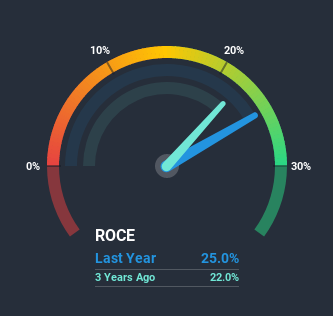The Underlying Trends At Qiwi (NASDAQ:QIWI) Look Strong

What are the early trends we should look for to identify a stock that could multiply in value over the long term? Firstly, we'll want to see a proven return on capital employed (ROCE) that is increasing, and secondly, an expanding base of capital employed. Basically this means that a company has profitable initiatives that it can continue to reinvest in, which is a trait of a compounding machine. That's why when we briefly looked at Qiwi's (NASDAQ:QIWI) ROCE trend, we were very happy with what we saw.
What is Return On Capital Employed (ROCE)?
For those who don't know, ROCE is a measure of a company's yearly pre-tax profit (its return), relative to the capital employed in the business. To calculate this metric for Qiwi, this is the formula:
Return on Capital Employed = Earnings Before Interest and Tax (EBIT) ÷ (Total Assets - Current Liabilities)
0.25 = ₽8.3b ÷ (₽69b - ₽36b) (Based on the trailing twelve months to June 2020).
Thus, Qiwi has an ROCE of 25%. That's a fantastic return and not only that, it outpaces the average of 10% earned by companies in a similar industry.
Check out our latest analysis for Qiwi
Above you can see how the current ROCE for Qiwi compares to its prior returns on capital, but there's only so much you can tell from the past. If you're interested, you can view the analysts predictions in our free report on analyst forecasts for the company.
The Trend Of ROCE
In terms of Qiwi's history of ROCE, it's quite impressive. The company has consistently earned 25% for the last five years, and the capital employed within the business has risen 65% in that time. Returns like this are the envy of most businesses and given it has repeatedly reinvested at these rates, that's even better. If Qiwi can keep this up, we'd be very optimistic about its future.
Another thing to note, Qiwi has a high ratio of current liabilities to total assets of 52%. This can bring about some risks because the company is basically operating with a rather large reliance on its suppliers or other sorts of short-term creditors. While it's not necessarily a bad thing, it can be beneficial if this ratio is lower.
Our Take On Qiwi's ROCE
In the end, the company has proven it can reinvest it's capital at high rates of returns, which you'll remember is a trait of a multi-bagger. However, over the last five years, the stock has only delivered a 3.9% return to shareholders who held over that period. So to determine if Qiwi is a multi-bagger going forward, we'd suggest digging deeper into the company's other fundamentals.
Like most companies, Qiwi does come with some risks, and we've found 2 warning signs that you should be aware of.
Qiwi is not the only stock earning high returns. If you'd like to see more, check out our free list of companies earning high returns on equity with solid fundamentals.
This article by Simply Wall St is general in nature. It does not constitute a recommendation to buy or sell any stock, and does not take account of your objectives, or your financial situation. We aim to bring you long-term focused analysis driven by fundamental data. Note that our analysis may not factor in the latest price-sensitive company announcements or qualitative material. Simply Wall St has no position in any stocks mentioned.
Have feedback on this article? Concerned about the content? Get in touch with us directly. Alternatively, email editorial-team@simplywallst.com.

 Yahoo News
Yahoo News 
